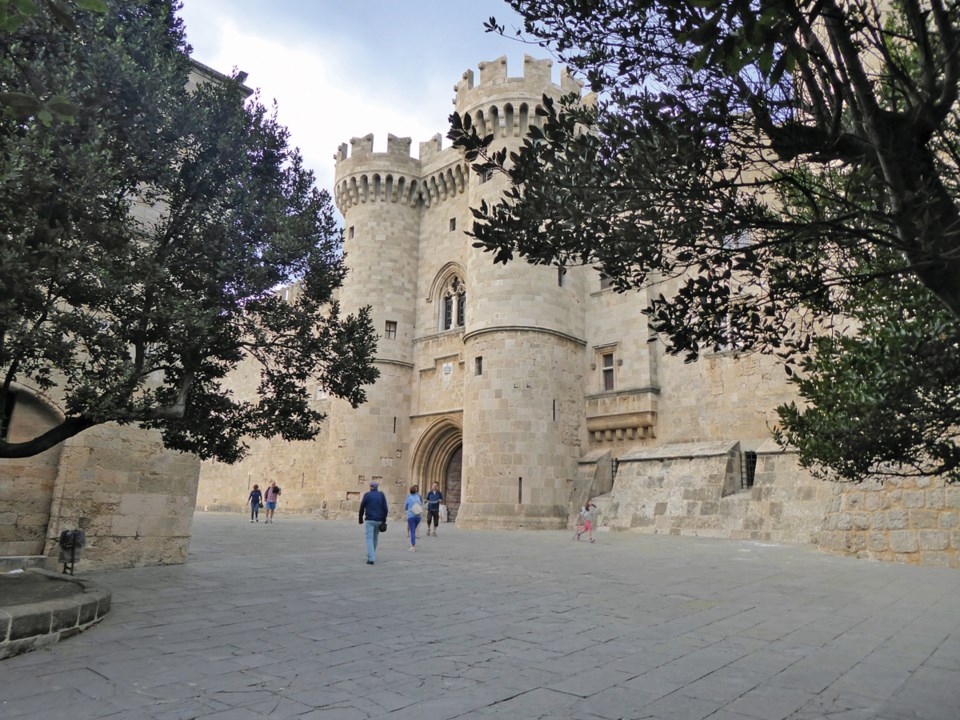Following a spectacular morning excursion investigating the Acropolis of Lindos, we add a self-guided walkabout inside the walled city of Rhodes. Hopping off the coach at the customs office, we pass through St. Catherine’s Gate and into the glorious days of yore.
Rhodes retains a 14th century lustre. High walls encircle splendid Gothic churches and homes of early squires, smithies and merchants who had served the Crusaders. Medieval masons refortified the original Byzantine wall and created their residences, complete with arched gateways, sculpted coats-of-arms and paved courtyards.
They also built the central Knights of St. John Hospital to care mainly for Holy Land pilgrims. Now an archaeological museum, we enter and immediately notice ground level archways at one time connecting storehouses. Crossing the sparse courtyard, we climb a wide staircase to an early infirmary. The rooms exhibit artifacts highlighting the noble knights’ lifestyles and zealous struggles to retain the Holy Land.
Crossing Knight’s Street, we glance inside Our Lady of the Castle Cathedral. Crusaders revamped this former Byzantine church to fit their needs. Then, when Suleiman the Magnificent conquered Rhodes, his Ottoman craftsmen converted their cathedral into a mosque and replaced the bell-tower with a soaring minaret.
Stone inns still line the cobbled street. Remaining above each arched doorway, emblems represent the language once spoken within. Contingents of English, Italian, Spanish, French and German knights were welcomed in these ‘Inns of Tongue.’
The street ends at the formidable Palace of the Grand Masters, Knights of St. John headquarters. Mussolini restored and embellished it as his residence during WWII. The Palace evolved into a museum with 24 rooms of treasures, including magnificent Grecian mosaic floors from Kos, Roman statuary and shiny Medieval armour.
Exiting southward, Chris and I walk to the lofty Medieval Clock Tower Roloi. For a small fee, we ascend outdoor stairways and climb the tower ladder to Rhodes’ highest, most heavenly viewpoint. We see our ship moored at the edge of the walled city. And amid leafy green trees below stands rosy-red domed Suleiman Mosque and Almshouse. Suleiman constructed these buildings just after his huge army defeated the Crusaders in 1522.
Along Socrates Street, stalls overflow with jewelry, pottery, clothing and embroidery. Veering onto a series of quiet lanes, our route passes a Muslim Library, another Ottoman mosque, Crusader and Byzantine churches and a famed Turkish bathhouse.
From Hippocrates Square, Aristotle Street takes us to the original Jewish quarter. Sea creatures and three large seahorses decorate a little fountain in Hebrew Martyrs Square. This park memorializes 1,000 plus Jews sent from Rhodes to Auschwitz.
Finding a Taverna in Hippocrates Square, we sip strong Greek coffee popularized by former occupying Ottomans. A Greek acquaintance taught me the custom of reading coffee dregs. Placing the saucer atop my cup, I swirl and flip it. Thumping it three times, the cup releases the grounds onto the saucer. The gritty message: ‘life is good.’ Having no ‘grounds’ for complaint, we saunter directly back to the ship.
Rhodes remains a wonder-filled World Heritage site. Today’s stroll through four splendid periods of history proves extraordinary. Laden with treasured memories and priceless insights, we return to our cozy cabin.



